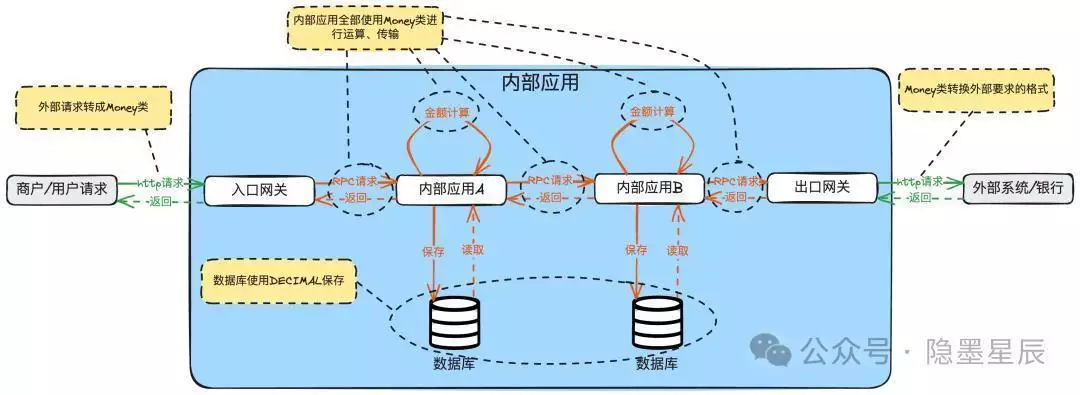资损防控:搞定跨境交易系统中金额处理规范志愿军有6个兵团,司令员回国后多数获得晋升:这两人为何降职?
在跨境交易日益频繁的当下,资损防控成为支付系统设计的关键环节。金额处理的规范性直接关系到资金安全与企业信誉。本文将深入探讨交易系统中金额计算、存储、传输的最佳实践,详细剖析常见资损场景及解决方案。

这篇文章主要讲清楚:交易系统(电商、支付等)金额处理常见资损场景,如何构建一个适合跨境支付业务(中国业务更不在话下)的Money类,应用Money的最佳实践,包括计算、存储、传输,目的是在金额处理上减少资损风险。
一、背景
前几天有读者私聊我问了几个问题:
“做国际支付,不同的币种的最小单位不同,比如人民币是分,日元是元,那数据库里面应该应该保存整数还是小数?”
“从哪里获取到这个币种的最小单位是多少?”
“我赞成你说的不应该直接对金额进行加减乘除操作,但我还是不知道怎么做,怎样才能落地呢?”
以前在公司时,也有兄弟部门因为金额处理不当,导致了好几万的资损故障,然后过来问我金额处理的最佳实践,当时也给他们做过一次相关分享。
二、金额处理场景

从上图可以看到,对于交易系统而言,一共有下面几种场景需要做金额处理:
接收外部请求。比如商户下单100元,或用户转账1000元。内部应用处理。比如计算手续费等。内部应用保存到数据库,从数据库读取。内部应用之间传输。发送给外部系统或银行渠道。比如向银行请求扣款100元。三、金额计算常见误区及严重后果
对于研发经验不足的团队而言,经常会犯以下几种错误:
没有定义统一的Money类,各系统间使用BigDecimal、double、long等数据类型进行金额处理及存储。定义了统一的Money类,但是写代码时不严格遵守,仍然有些代码使用BigDecimal、double、long等数据类型进行金额处理。手动对金额进行加、减、乘、除运算,单位(元与分)换算。带来的后果,通常就是资金损失,再细化一下,最常见的情况有下面3种:
1)手动做单位换算导致金额被放大或缩小100倍。
比如大家规定传的是元,但是其中有位同学忘记了,以为传的是分,外部渠道要求传元,就手动乘以100。或者反过来。还有一种情况,部分币种比如日元最小单元就是元,假如系统约定传的是分,外部渠道要求传元,就可能在网关处理时手动乘以100。2)1分钱归属问题。比如结算给商家,或计算手续费时,碰到除不尽时,使用四舍五入,还是向零舍入,还是银行家舍入?这取决于财务策略。
3)精度丢失。在大金额时,double有可能会有精度丢失问题。
四、金额处理原则

直接上答案:
制定适用于公司业务的Money类来统一处理金额。在入口网关接收到请求后,就转换为Money类。所有内部应用的金额处理,强制全部使用Money类运算、传输,禁止自己手动加减乘除、单位换算(比如元到分)。数据库使用DECIMAL类型保存,保存单位为元。在出口网关外发时,再根据外部接口文档要求,转换成使用指定的单位。有些是元,有些是分(最小货币单位)五、制定Money类
JAVA有制定金额处理规范JSR 354(Java Specification Request 354),对应的实现包是Java Money API(javax.money),它提供了一套用于处理货币和货币计算的API。不过我们通常选择实现自己的Money类,主要是方便,可以自由定制,比如小数舍入问题。
一个Money类通常包括以下几个主要方面:
通过参数生成一个Money类。加减乘除处理。比较处理。获取金额(元)和获取最小单位金额(元或分)。下面的代码由ChatGPT o1模型生成。
提示词为:
编写一个Money类,支持跨境支付场景下的多币种诉求。要求:
1)实现Comparable和Serializable。
2)成员变量币种使用BigDecimal amount,Currency currency。
3)静态方法传入币种和数字返回一个Money类实例。
4)支持:加、减、乘、除、比较大小操作,加减和比较需要判断币种相同。
5)默认使用四余五入,但是支持RoundingMode能力。
6)提供getAmount和getAmountMinorUnit方法,前者返回单位元,后者返回币种的最小单位,通过
Currency.getDefaultFractionDigits和amount计算出来。生成的 Money 类实现了跨境支付场景下多币种的高精度金额处理,满足了以下关键需求:
实现了 Comparable 和 Serializable 接口,支持排序和序列化。使用 BigDecimal 和 Currency 来表示金额和币种,确保高精度和标准化。提供了丰富的操作方法,包括加、减、乘、除,并且支持自定义和四舍五入模式。提供了 getAmount 和 getAmountMinorUnit 方法,分别返回单位元和最小单位的金额。确保类的不可变性和线程安全性。根据币种自动计算出最小单位,比如人民币就是分,而日元就是元。只有相同币种才能做加、减。乘除支持舍入,默认使用四舍五入,但是支持其它舍入方式。通过这种设计,可以在跨境支付、金融应用等需要高精度、多币种支持的场景中安全、有效地使用 Money 类进行金额处理。
后面会做拆解说明。
完整代码如下:
import java.io.Serializable; import java.math.BigDecimal; import java.math.RoundingMode; import java.util.Currency; import java.util.Objects; /** * Money类用于表示不同币种的金额,支持高精度计算和多币种操作。 * 该类是不可变的(immutable),并且实现了Comparable和Serializable接口。 */ public final class Money implements Comparable, Serializable { private static final long serialVersionUID = 1L; private final BigDecimal amount; private final Currency currency; /** * 私有构造函数,确保通过工厂方法创建实例。 * * @param amount 金额,单位为元 * @param currency 币种,非空 */ private Money(BigDecimal amount, Currency currency) { if (amount == null) { throw new IllegalArgumentException("Amount cannot be null."); } if (currency == null) { throw new IllegalArgumentException("Currency cannot be null."); } this.amount = amount; this.currency = currency; } /** * 静态工厂方法,通过传入Currency和BigDecimal金额创建Money实例。 * 默认使用RoundingMode.HALF_UP进行四舍五入。 * * @param currency 币种 * @param amount 金额,单位为元 * @return 新的Money实例 */ public static Money of(Currency currency, BigDecimal amount) { return of(currency, amount, RoundingMode.HALF_UP); } /** * 静态工厂方法,通过传入Currency和BigDecimal金额创建Money实例。 * 允许指定RoundingMode进行四舍五入。 * * @param currency 币种 * @param amount 金额,单位为元 * @param roundingMode 四舍五入模式 * @return 新的Money实例 */ public static Money of(Currency currency, BigDecimal amount, RoundingMode roundingMode) { Objects.requireNonNull(currency, "Currency cannot be null."); Objects.requireNonNull(amount, "Amount cannot be null."); Objects.requireNonNull(roundingMode, "RoundingMode cannot be null."); BigDecimal scaledAmount = amount.setScale( currency.getDefaultFractionDigits, roundingMode ); return new Money(scaledAmount, currency); } /** * 加法操作,返回新的Money实例。 * 仅允许相同币种的加法操作。 * * @param other 加数 * @return 相加后的Money实例 * @throws IllegalArgumentException 如果币种不一致 */ public Money add(Money other) { validateSameCurrency(other); BigDecimal resultAmount = this.amount.add(other.amount); return new Money(resultAmount, this.currency); } /** * 减法操作,返回新的Money实例。 * 仅允许相同币种的减法操作。 * * @param other 减数 * @return 相减后的Money实例 * @throws IllegalArgumentException 如果币种不一致 */ public Money subtract(Money other) { validateSameCurrency(other); BigDecimal resultAmount = this.amount.subtract(other.amount); return new Money(resultAmount, this.currency); } /** * 乘法操作,使用默认舍入模式(RoundingMode.HALF_UP),返回新的Money实例。 * * @param multiplier 乘数 * @return 乘法后的Money实例 * @throws ArithmeticException 如果需要进行舍入但无法进行 * @throws IllegalArgumentException 如果multiplier为null */ public Money multiply(BigDecimal multiplier) { return multiply(multiplier, RoundingMode.HALF_UP); } /** * 乘法操作,返回新的Money实例。 * * @param multiplier 乘数 * @param roundingMode 四舍五入模式 * @return 乘法后的Money实例 * @throws ArithmeticException 如果需要进行舍入但没有指定舍入模式 * @throws IllegalArgumentException 如果multiplier或roundingMode为null */ public Money multiply(BigDecimal multiplier, RoundingMode roundingMode) { Objects.requireNonNull(multiplier, "Multiplier cannot be null."); Objects.requireNonNull(roundingMode, "RoundingMode cannot be null."); BigDecimal resultAmount = this.amount.multiply(multiplier) .setScale(currency.getDefaultFractionDigits, roundingMode); return new Money(resultAmount, this.currency); } /** * 除法操作,返回新的Money实例。 * * @param divisor 除数 * @param scale 保留的小数位数 * @param roundingMode 四舍五入模式 * @return 除法后的Money实例 * @throws ArithmeticException 如果除数为零或无法精确表示 * @throws IllegalArgumentException 如果divisor或roundingMode为null */ public Money divide(BigDecimal divisor, int scale, RoundingMode roundingMode) { Objects.requireNonNull(divisor, "Divisor cannot be null."); Objects.requireNonNull(roundingMode, "RoundingMode cannot be null."); if (divisor.compareTo(BigDecimal.ZERO) == 0) { throw new ArithmeticException("Division by zero."); } BigDecimal resultAmount = this.amount.divide(divisor, scale, roundingMode) .setScale(currency.getDefaultFractionDigits, roundingMode); return new Money(resultAmount, this.currency); } /** * 比较大小,仅允许相同币种的比较。 * * @param other 要比较的Money对象 * @return 负数、零或正数,分别表示小于、等于或大于 * @throws IllegalArgumentException 如果币种不一致 */ @Override public int compareTo(Money other) { validateSameCurrency(other); return this.amount.compareTo(other.amount); } /** * 获取金额,单位为元。 * * @return 金额 */ public BigDecimal getAmount { return amount; } /** * 获取最小单位金额,通过Currency.getDefaultFractionDigits和amount计算。 * 例如,人民币1元 = 100分,日元1元 = 1元。 * * @return 最小单位金额 */ public BigDecimal getAmountMinorUnit { int fractionDigits = currency.getDefaultFractionDigits; return amount.movePointRight(fractionDigits); } /** * 获取币种。 * * @return 币种 */ public Currency getCurrency { return currency; } /** * 校验两个Money对象的币种是否相同。 * * @param other 另一个Money对象 * @throws IllegalArgumentException 如果币种不一致 */ private void validateSameCurrency(Money other) { if (!this.currency.equals(other.currency)) { throw new IllegalArgumentException("Currencies do not match."); } } /** * 重写equals方法,基于金额和币种判断相等。 * * @param o 其他对象 * @return 是否相等 */ @Override public boolean equals(Object o) { if (this == o) return true; if (o == null || getClass != o.getClass) return false; Money money = (Money) o; return amount.equals(money.amount) && currency.equals(money.currency); } /** * 重写hashCode方法,基于金额和币种生成哈希码。 * * @return 哈希码 */ @Override public int hashCode { return Objects.hash(amount, currency); } /** * 重写toString方法,格式化输出币种和金额。 * * @return 格式化后的字符串 */ @Override public String toString { return String.format("%s %s", currency.getCurrencyCode, amount); } }下面做拆解说明。
5.1. 核心属性
public final class Money implements Comparable, Serializable { private static final long serialVersionUID = 1L; private final BigDecimal amount; private final Currency currency; }5.2. 通过金额数值和币种构建一个Money类
/** * 私有构造函数,确保通过工厂方法创建实例。 * * @param amount 金额,单位为元 * @param currency 币种,非空 */ private Money(BigDecimal amount, Currency currency) { if (amount == null) { throw new IllegalArgumentException("Amount cannot be null."); } if (currency == null) { throw new IllegalArgumentException("Currency cannot be null."); } this.amount = amount; this.currency = currency; } /** * 静态工厂方法,通过传入Currency和BigDecimal金额创建Money实例。 * 默认使用RoundingMode.HALF_UP进行四舍五入。 * * @param currency 币种 * @param amount 金额,单位为元 * @return 新的Money实例 */ public static Money of(Currency currency, BigDecimal amount) { return of(currency, amount, RoundingMode.HALF_UP); } /** * 静态工厂方法,通过传入Currency和BigDecimal金额创建Money实例。 * 允许指定RoundingMode进行四舍五入。 * * @param currency 币种 * @param amount 金额,单位为元 * @param roundingMode 四舍五入模式 * @return 新的Money实例 */ public static Money of(Currency currency, BigDecimal amount, RoundingMode roundingMode) { Objects.requireNonNull(currency, "Currency cannot be null."); Objects.requireNonNull(amount, "Amount cannot be null."); Objects.requireNonNull(roundingMode, "RoundingMode cannot be null."); BigDecimal scaledAmount = amount.setScale( currency.getDefaultFractionDigits, roundingMode ); return new Money(scaledAmount, currency); }5.3. 加减乘除
1)注意除法有除不尽舍入的问题,需要根据业务来指定舍入的模式,建议默认提供四舍五入,但是保留指定模式的能力。具体可以参考:java.math.RoundingMode。
UP:远零方向舍入。示例:1.6返回2,-1.6返回-2。DOWN:向零方向舍入。示例:1.6返回1,-1.6返回-1。CEILING:向上舍入。示例:1.6返回2,-1.6返回-1。FLOOR:向下舍入。示例:1.6返回1,-1.6返回-2。HALF_UP:四舍五入。示例:1.5返回2,-1.5返回-2。HALF_DOWN:五舍六入。示例:1.5返回1,-1.5返回-1,1.6返回2,-1.6返回-2。HALF_EVEN:银行家算法,尾数小于0.5舍,尾数大于0.5入,尾数等于0.5往最终结果是偶数的方向进。示例:1.51返回2,-1.49返回-1,2.5返回2,3.5返回4(1.5,2.5,3.5,4.5,5.5等这些最终只出现2,4,4,4,6等偶数)。2)加和减,需要先判断币种,只有币种相同才能做加减。
/** * 加法操作,返回新的Money实例。 * 仅允许相同币种的加法操作。 * * @param other 加数 * @return 相加后的Money实例 * @throws IllegalArgumentException 如果币种不一致 */ public Money add(Money other) { validateSameCurrency(other); BigDecimal resultAmount = this.amount.add(other.amount); return new Money(resultAmount, this.currency); } /** * 减法操作,返回新的Money实例。 * 仅允许相同币种的减法操作。 * * @param other 减数 * @return 相减后的Money实例 * @throws IllegalArgumentException 如果币种不一致 */ public Money subtract(Money other) { validateSameCurrency(other); BigDecimal resultAmount = this.amount.subtract(other.amount); return new Money(resultAmount, this.currency); } /** * 乘法操作,使用默认舍入模式(RoundingMode.HALF_UP),返回新的Money实例。 * * @param multiplier 乘数 * @return 乘法后的Money实例 * @throws ArithmeticException 如果需要进行舍入但无法进行 * @throws IllegalArgumentException 如果multiplier为null */ public Money multiply(BigDecimal multiplier) { return multiply(multiplier, RoundingMode.HALF_UP); } /** * 乘法操作,返回新的Money实例。 * * @param multiplier 乘数 * @param roundingMode 四舍五入模式 * @return 乘法后的Money实例 * @throws ArithmeticException 如果需要进行舍入但没有指定舍入模式 * @throws IllegalArgumentException 如果multiplier或roundingMode为null */ public Money multiply(BigDecimal multiplier, RoundingMode roundingMode) { Objects.requireNonNull(multiplier, "Multiplier cannot be null."); Objects.requireNonNull(roundingMode, "RoundingMode cannot be null."); BigDecimal resultAmount = this.amount.multiply(multiplier) .setScale(currency.getDefaultFractionDigits, roundingMode); return new Money(resultAmount, this.currency); } /** * 除法操作,返回新的Money实例。 * * @param divisor 除数 * @param scale 保留的小数位数 * @param roundingMode 四舍五入模式 * @return 除法后的Money实例 * @throws ArithmeticException 如果除数为零或无法精确表示 * @throws IllegalArgumentException 如果divisor或roundingMode为null */ public Money divide(BigDecimal divisor, int scale, RoundingMode roundingMode) { Objects.requireNonNull(divisor, "Divisor cannot be null."); Objects.requireNonNull(roundingMode, "RoundingMode cannot be null."); if (divisor.compareTo(BigDecimal.ZERO) == 0) { throw new ArithmeticException("Division by zero."); } BigDecimal resultAmount = this.amount.divide(divisor, scale, roundingMode) .setScale(currency.getDefaultFractionDigits, roundingMode); return new Money(resultAmount, this.currency); }5.4. 比较大小
/** * 比较大小,仅允许相同币种的比较。 * * @param other 要比较的Money对象 * @return 负数、零或正数,分别表示小于、等于或大于 * @throws IllegalArgumentException 如果币种不一致 */ @Override public int compareTo(Money other) { validateSameCurrency(other); return this.amount.compareTo(other.amount); }5.5. 返回元和分单位的数字
所有内部应用全部使用getAmount,不允许使用getAmountMinorUnit。保证内部应用大家的语义保持一致。
只有请求外部渠道时,如果渠道要求使用币种最小单位,才使用getAmountMinorUnit。
/** * 获取金额,单位为元。 * * @return 金额 */ public BigDecimal getAmount { return amount; } /** * 获取最小单位金额,通过Currency.getDefaultFractionDigits和amount计算。 * 例如,人民币1元 = 100分,日元1元 = 1元。 * * @return 最小单位金额 */ public BigDecimal getAmountMinorUnit { int fractionDigits = currency.getDefaultFractionDigits; return amount.movePointRight(fractionDigits); }六、Money类实际应用最佳实践
从接收外部请求开始,到内部计算、存储,最后外发到渠道,完整实践说明。
6.1. 接收入口请求
在入口网关处,先转换成Money类,再往后请求。
// 使用外部请求的参数构建Money类 Money payAmount = Money.of(BigDecimal.valueOf(outRequest.getPayAmount), outRequest.getCurrency); // 构建内部请求 PayRequest request = new PayRequest; request.setPayAmount(payAmount); ... ... // 发给内部应用 payService.pay(request);6.2. 内部应用运算
内部所有应用,全部使用Money类流转和计算。
Money payAmount = request.getPayAmount; Money fee = payAmount.multiply(BigDecimal.valueOf(0.03)); // 其它处理6.3. 内部数据库存储
Money payAmount = request.getPayAmount; BigDecimal amount = payAmount.getAmount; String currency = payAmount.getCurrency.getCurrencyCode; // 构建DO Order order = new Order; order.setAmount(amount); order.setCurrency(currency); ... // 保存入库 saveToDB(order);6.4. 外发处理
渠道要求是元,使用:
payAmount.getAmount;如果要求是分或最小币种单位,使用:
payAmount.getAmountMinorUnit;7. 结束语
金额如果处理得不好,带来的直接后果就是资金损失,哪怕不是今天,早晚也得出事。
如果你是研发同学,发现内部还没有使用Money类处理金额,建议早点对内部系统做改造。如果你是产品经理,建议转给内部研发工程师,避免踩资损的坑。
本文由人人都是产品经理作者【隐墨星辰】,微信公众号:【隐墨星辰】,原创/授权 发布于人人都是产品经理,未经许可,禁止转载。
题图来自Unsplash,基于 CC0 协议。